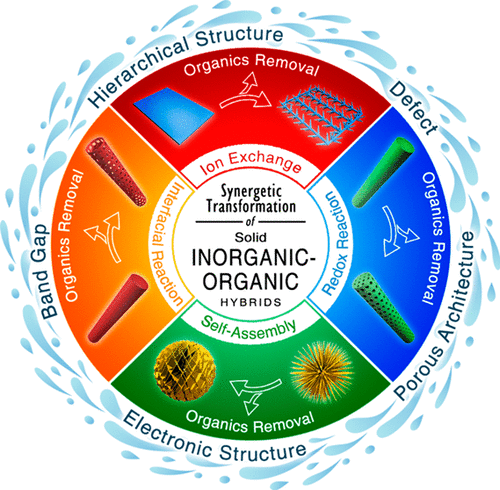当前位置:
X-MOL 学术
›
Acc. Chem. Res.
›
论文详情
Our official English website, www.x-mol.net, welcomes your
feedback! (Note: you will need to create a separate account there.)
Synergetic Transformation of Solid Inorganic–Organic Hybrids into Advanced Nanomaterials for Catalytic Water Splitting
Accounts of Chemical Research ( IF 16.4 ) Pub Date : 2018-06-22 00:00:00 , DOI: 10.1021/acs.accounts.8b00193 Yifu Yu 1 , Yanmei Shi 1 , Bin Zhang 1
Accounts of Chemical Research ( IF 16.4 ) Pub Date : 2018-06-22 00:00:00 , DOI: 10.1021/acs.accounts.8b00193 Yifu Yu 1 , Yanmei Shi 1 , Bin Zhang 1
Affiliation

|
The rational synthesis of advanced nanomaterials with well-defined structures has been intensively studied due to the remarkable properties and intriguing applications of the formed materials. Recently, inorganic–organic hybrids have been widely adopted as precursors for chemical transformations toward the preparation of diverse nanomaterials. Specifically, inorganic and organic species with nano/molecule/atom-scale distribution serve as self-templates and sacrificial agents, respectively, endowing the products with controlled morphologies, band gaps, defects, and spatial architectures. However, previous works have focused mostly on the transformation of porous coordination polymers, such as metal–organic frameworks (MOFs), which would produce daughter nanomaterials with the inherited structure of their parental hybrids. Moreover, conventional transformation strategies often encounter difficulties in simultaneously manipulating multiple structural parameters of the target materials. Therefore, a synergetic transformation strategy involving the simultaneous removal of organic components and the reconstruction of inorganic components to transform solid inorganic–organic hybrids into functional nanomaterials is developed.
中文翻译:

固体无机-有机杂化物协同转化为先进的纳米材料,用于催化水分解
由于形成材料的卓越性能和吸引人的应用,已经深入研究了具有明确结构的先进纳米材料的合理合成。近来,无机-有机杂化物已被广泛用作制备各种纳米材料的化学转化的前体。具体而言,具有纳米/分子/原子级分布的无机和有机物质分别充当自模板和牺牲剂,赋予产品可控的形态,带隙,缺陷和空间结构。但是,以前的工作主要集中在多孔配位聚合物的转化上,例如金属有机骨架(MOF),它将产生具有其亲本杂种遗传结构的子纳米材料。而且,传统的转化策略在同时操纵目标材料的多个结构参数时经常遇到困难。因此,开发了一种协同转化策略,包括同时去除有机成分和重建无机成分,以将固体无机-有机杂化体转化为功能纳米材料。
更新日期:2018-06-22
中文翻译:

固体无机-有机杂化物协同转化为先进的纳米材料,用于催化水分解
由于形成材料的卓越性能和吸引人的应用,已经深入研究了具有明确结构的先进纳米材料的合理合成。近来,无机-有机杂化物已被广泛用作制备各种纳米材料的化学转化的前体。具体而言,具有纳米/分子/原子级分布的无机和有机物质分别充当自模板和牺牲剂,赋予产品可控的形态,带隙,缺陷和空间结构。但是,以前的工作主要集中在多孔配位聚合物的转化上,例如金属有机骨架(MOF),它将产生具有其亲本杂种遗传结构的子纳米材料。而且,传统的转化策略在同时操纵目标材料的多个结构参数时经常遇到困难。因此,开发了一种协同转化策略,包括同时去除有机成分和重建无机成分,以将固体无机-有机杂化体转化为功能纳米材料。











































 京公网安备 11010802027423号
京公网安备 11010802027423号